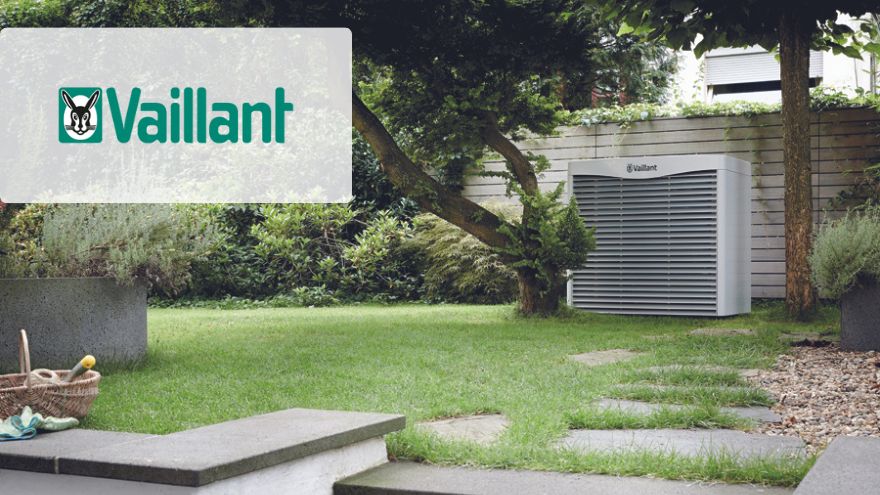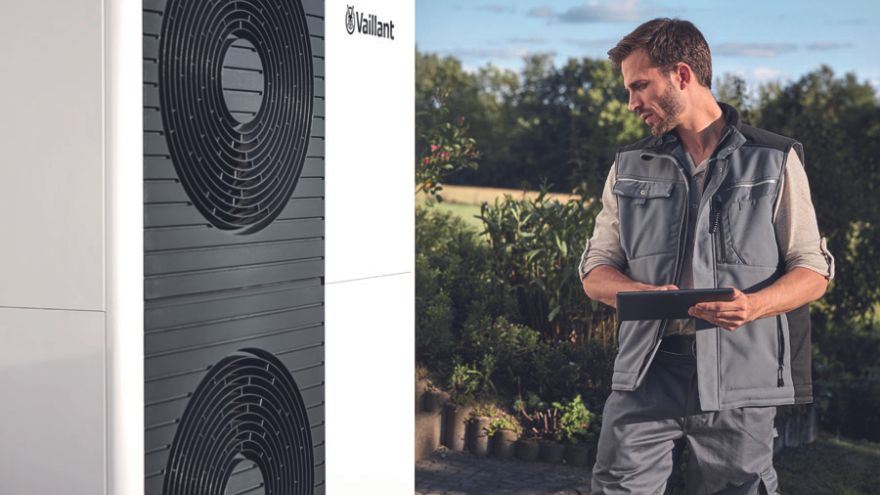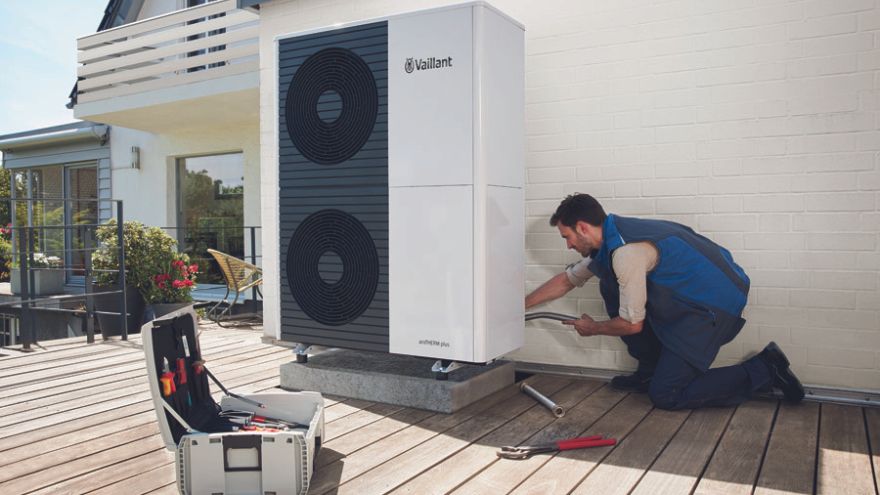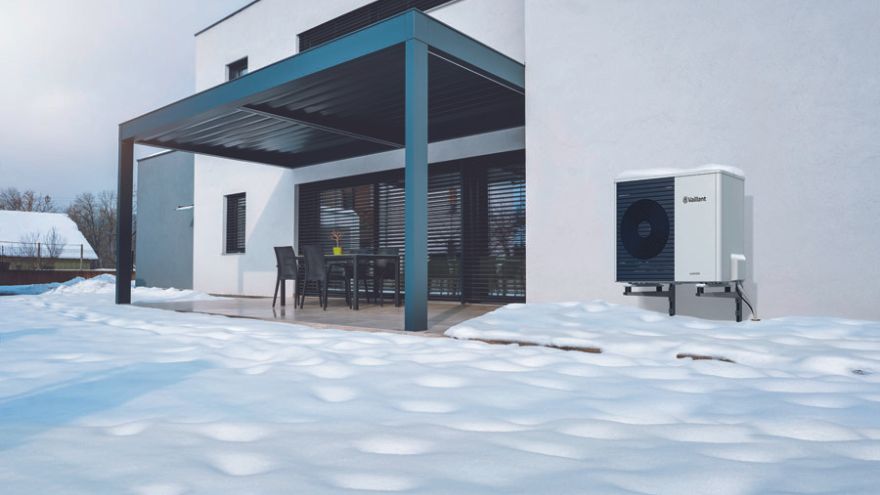Planning a heating system based on a heat pump requires precise determination of the building's heat losses. The heat pump transports energy from the immediate surroundings of the building and uses it for heating and domestic hot water preparation. Free and renewable heat energy is taken from atmospheric air in the case of air heat pumps or from the ground in brine pumps. We explain how to calculate the power of a heat pump and why its correct selection is so important.

From this article you will learn:
- why power selection is important,
- how to choose the power of a ground pump,
- how to choose the power of an air-water pump.
In order for the heat transport process to be possible using a modern Vaillant heat pump, it is necessary to supply electricity to the compressor, which drives the process in a closed thermodynamic cycle. The amount of electricity used in this process is several times smaller than the amount of renewable energy taken from the environment. However, in the case of heat pumps, it is very important to ensure optimal operating conditions. This means that these devices should be precisely matched to the needs of the building and the needs of the residents. Therefore, you need to answer an important question: How to select the power of the heat pump?
Why is accurate calculation of heat pump power important?
 The practice of selecting heating devices shows that heat pumps with high power are often selected in buildings, even higher than the actual demand of the building. However, choosing "in stock" is usually not good for either the environment or the users' wallets. In the case of heat pumps, improper selection of power may lead to faster wear of the device and an increase in operating costs.
The practice of selecting heating devices shows that heat pumps with high power are often selected in buildings, even higher than the actual demand of the building. However, choosing "in stock" is usually not good for either the environment or the users' wallets. In the case of heat pumps, improper selection of power may lead to faster wear of the device and an increase in operating costs.
Due to the efficiency of the heat pump and ensuring optimal conditions for the compressor, it is beneficial to operate it in long cycles. Selecting a heat pump with too high a power will not only result in higher investment costs. It may also lead to the so-called clocking, i.e. frequent switching on and off of the device. This phenomenon is unfavorable because the refrigeration circuit is unable to operate in stable conditions and it is necessary to start the compressor frequently, which may reduce its service life . In turn, a heat pump with too low power will exert a lot of effort and may not provide full thermal comfort in the building. It may also result in the peak heat source, e.g. an electric heater, being turned on too quickly, which will result in higher heating bills.
Check out the offer of Vaillant heat pumps at the Onninen wholesaler
How to choose the power of a ground heat pump?
Ground pumps, e.g. Vaillant flexoCOMPACT , are usually single-stage devices. This means that for given conditions of the lower and upper sources, the pump operates all the time with the same power. The power of the heat pump should be selected so as to fully supply the building with heat for the design temperature of a given climate zone. This means that during transitional periods the pump operates at a power higher than the actual demand of the building.
 To ensure that it can operate in sufficiently long cycles, it is recommended to increase the water load of the heating installation by using a buffer or underfloor heating without active flow regulation. Underestimating the power in the case of ground heat pumps may also lead to excessive cooling of the lower heat source. This leads to a reduction in work efficiency and, in extreme cases, may result in the destruction of the ground source.
To ensure that it can operate in sufficiently long cycles, it is recommended to increase the water load of the heating installation by using a buffer or underfloor heating without active flow regulation. Underestimating the power in the case of ground heat pumps may also lead to excessive cooling of the lower heat source. This leads to a reduction in work efficiency and, in extreme cases, may result in the destruction of the ground source.
What is the optimal power of an air-to-water heat pump?
Air source heat pumps, such as Vaillant aroTHERM , are equipped with an inverter that allows power modulation. This is important because, unlike ground pumps that have stable conditions in the lower heat source, air pumps draw energy from atmospheric air, the temperature of which fluctuates significantly. Due to the operating characteristics , the heat pump's power decreases as the outdoor temperature decreases . The inverter allows you to prevent power fluctuations and, to some extent, continuously adjust the pump power to the current demand.
 Due to operation at atmospheric air temperature, the power of air-to-water heat pumps is not matched to the building's demand for design temperatures. This would involve significant oversizing of equipment, leading to high investment outlays. It should also be borne in mind that the compressor speed modulation capabilities have certain limitations. In practice , selecting a heat pump with too high a power could mean that during periods of moderate temperatures, the minimum power generated by the heating device exceeds the building's demand . This would lead to frequent start cycles, which is bad for the compressor.
Due to operation at atmospheric air temperature, the power of air-to-water heat pumps is not matched to the building's demand for design temperatures. This would involve significant oversizing of equipment, leading to high investment outlays. It should also be borne in mind that the compressor speed modulation capabilities have certain limitations. In practice , selecting a heat pump with too high a power could mean that during periods of moderate temperatures, the minimum power generated by the heating device exceeds the building's demand . This would lead to frequent start cycles, which is bad for the compressor.
Depending on the climate zone, a good practice is to select the power of an air-water heat pump in mono-energy mode so that it covers 100% of the heat demand at temperatures of approximately -8° C to -12° C. Below this temperature ( bivalent point), the peak source is additionally activated - an electric heater. Due to the fact that during a typical heating season there are few days with very low temperatures, the share of work of the additional source with a properly selected device is small - it should be below 2% per year.
Therefore, the correct selection of heat pump power is extremely important and depends not only on the conditions in which it will be installed, but also on the type of device selected. Appropriate calculation of the heat pump's power will ensure that the device will operate smoothly and efficiently for many years, and we will enjoy thermal comfort and savings at the maximum possible level.
Check out the offer of Vaillant heat pumps at the Onninen wholesaler